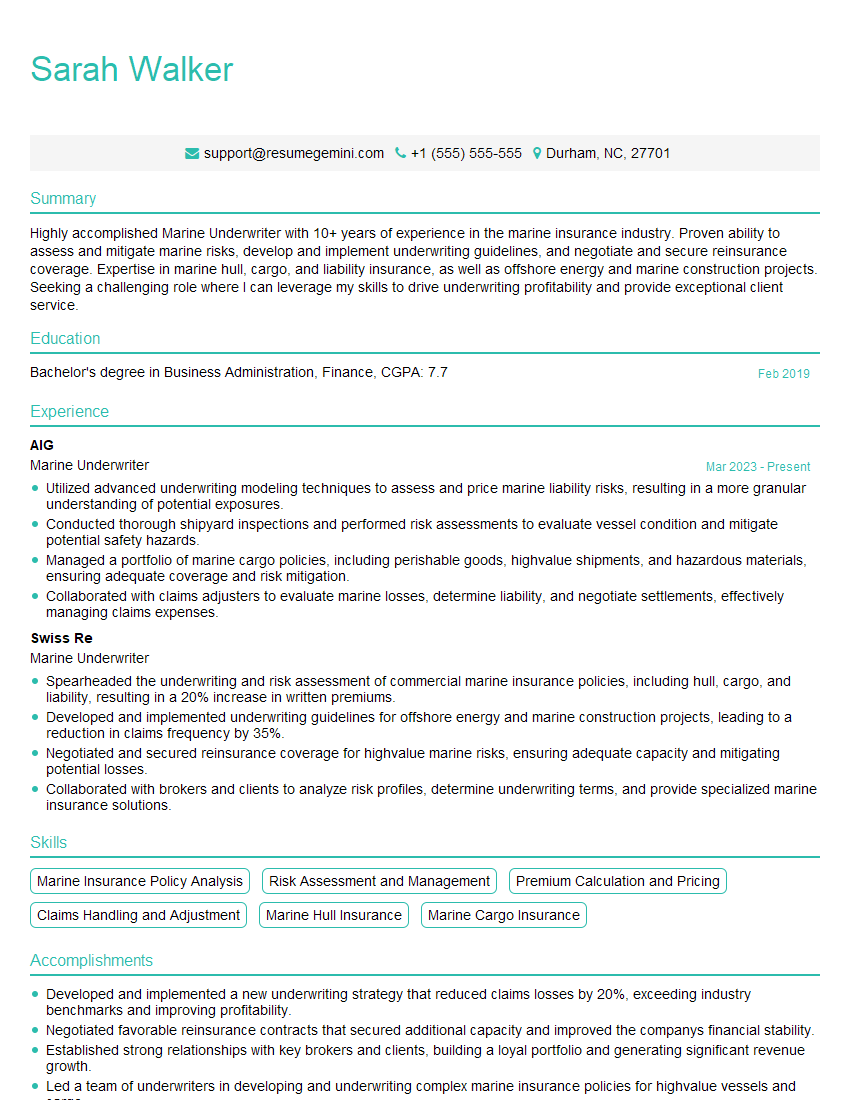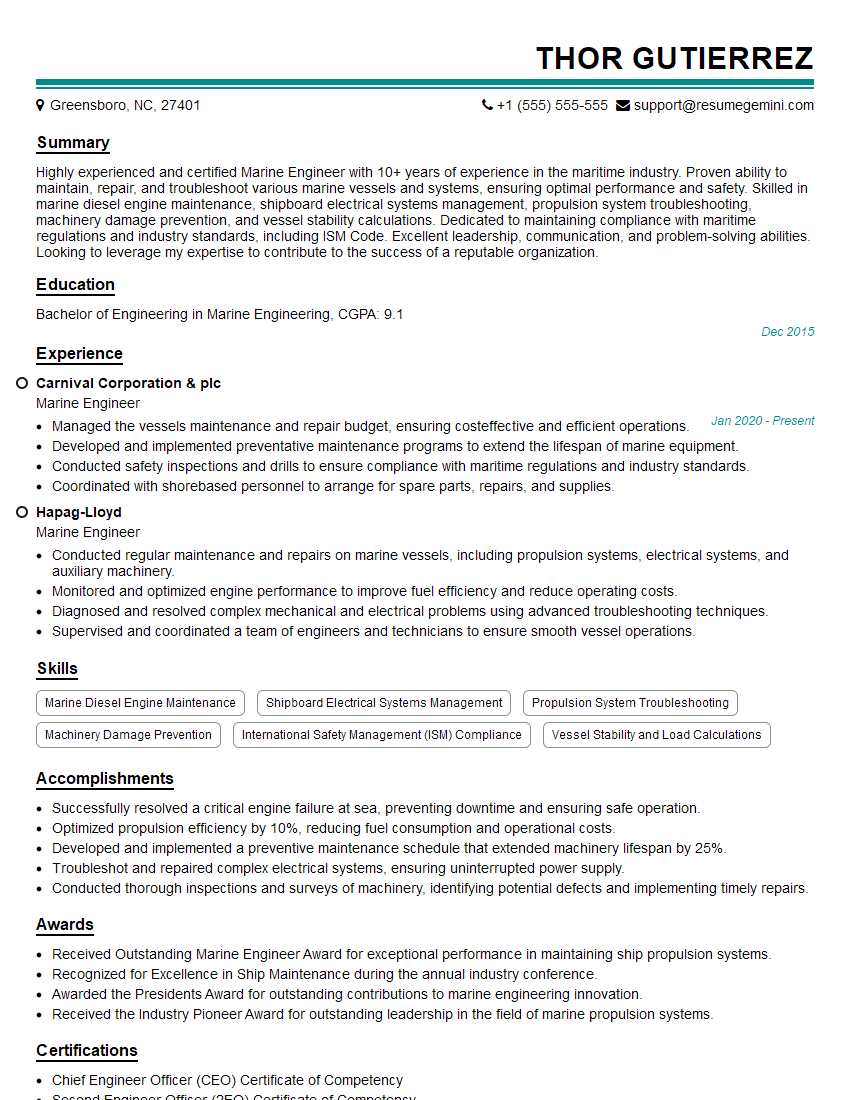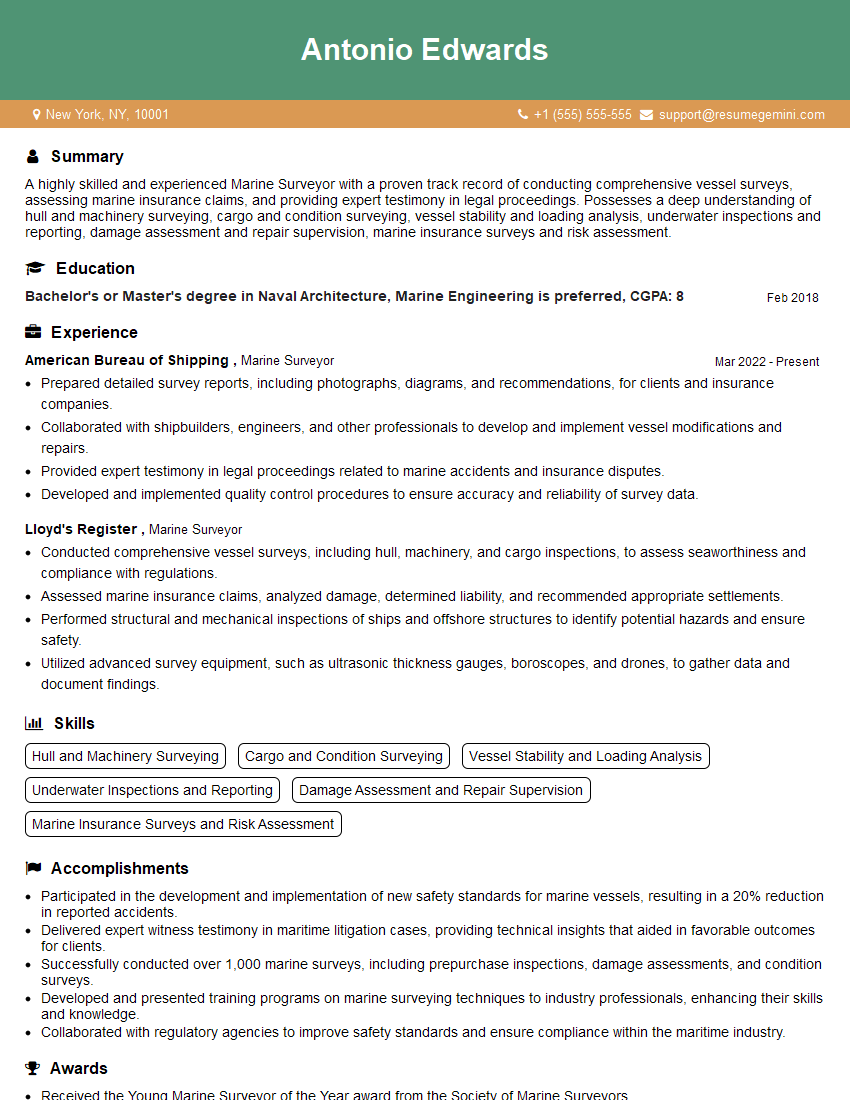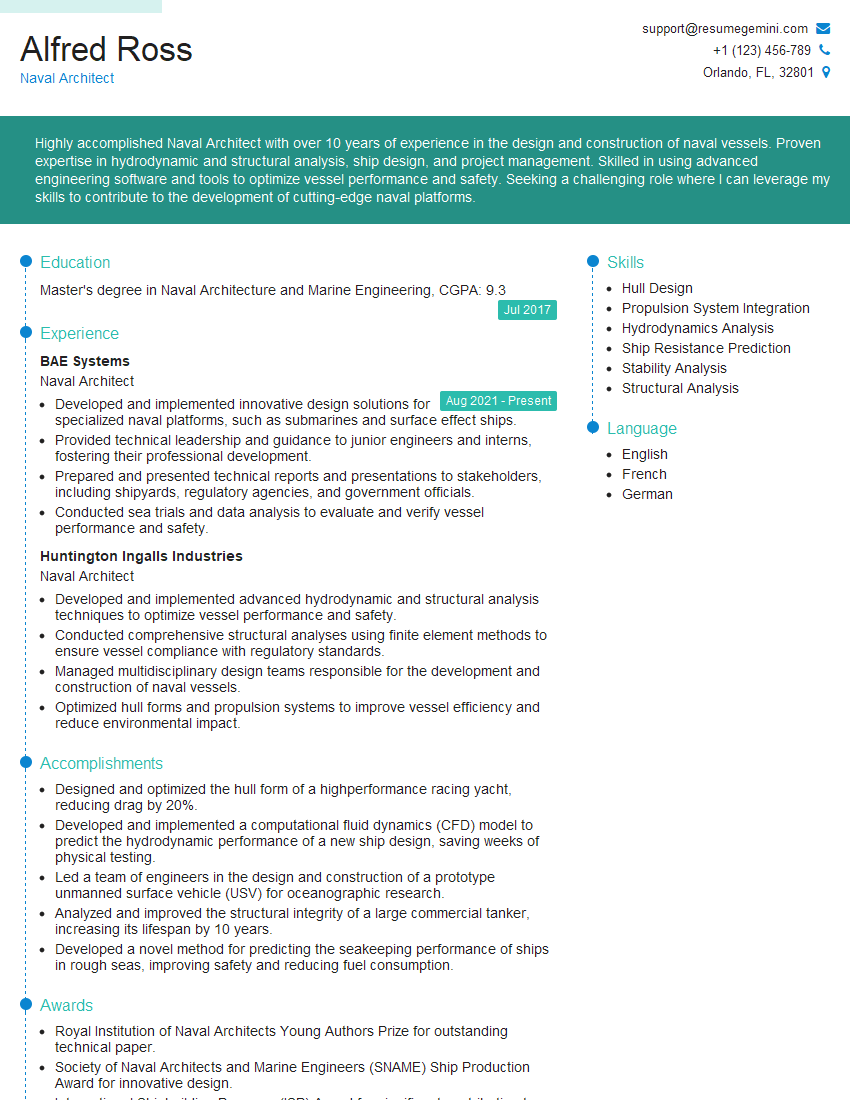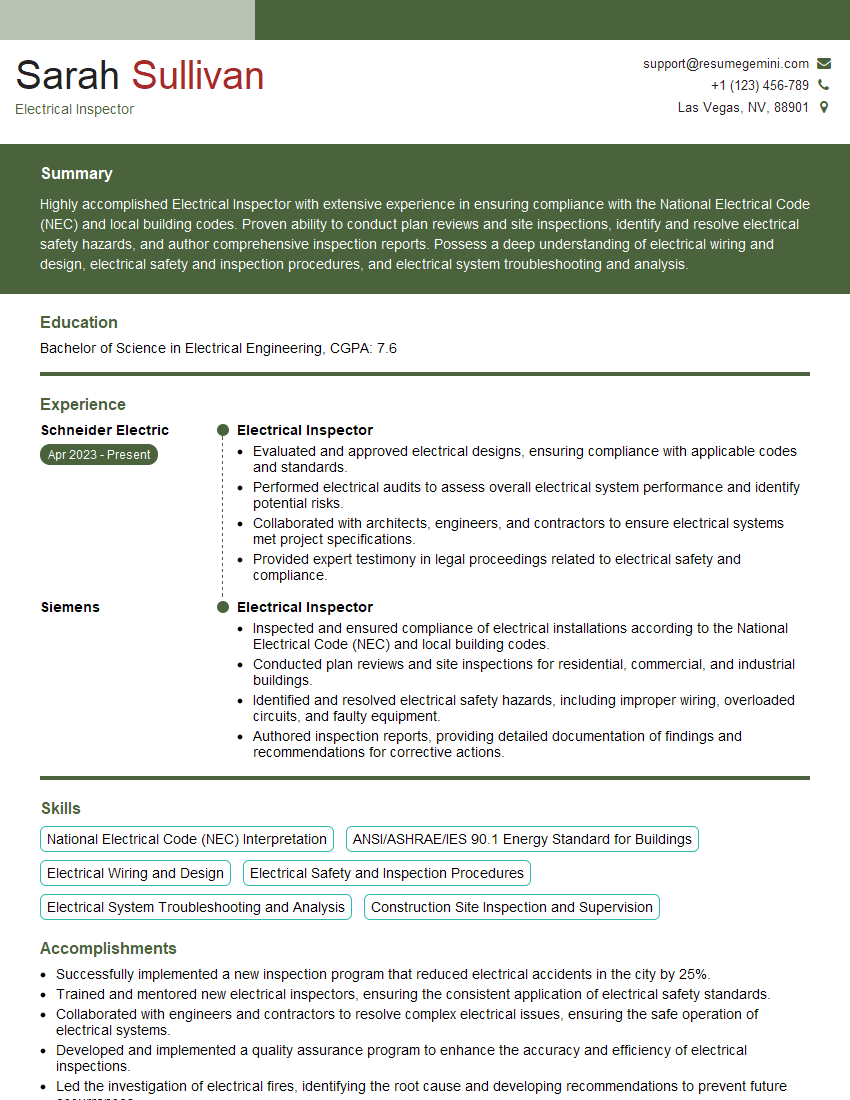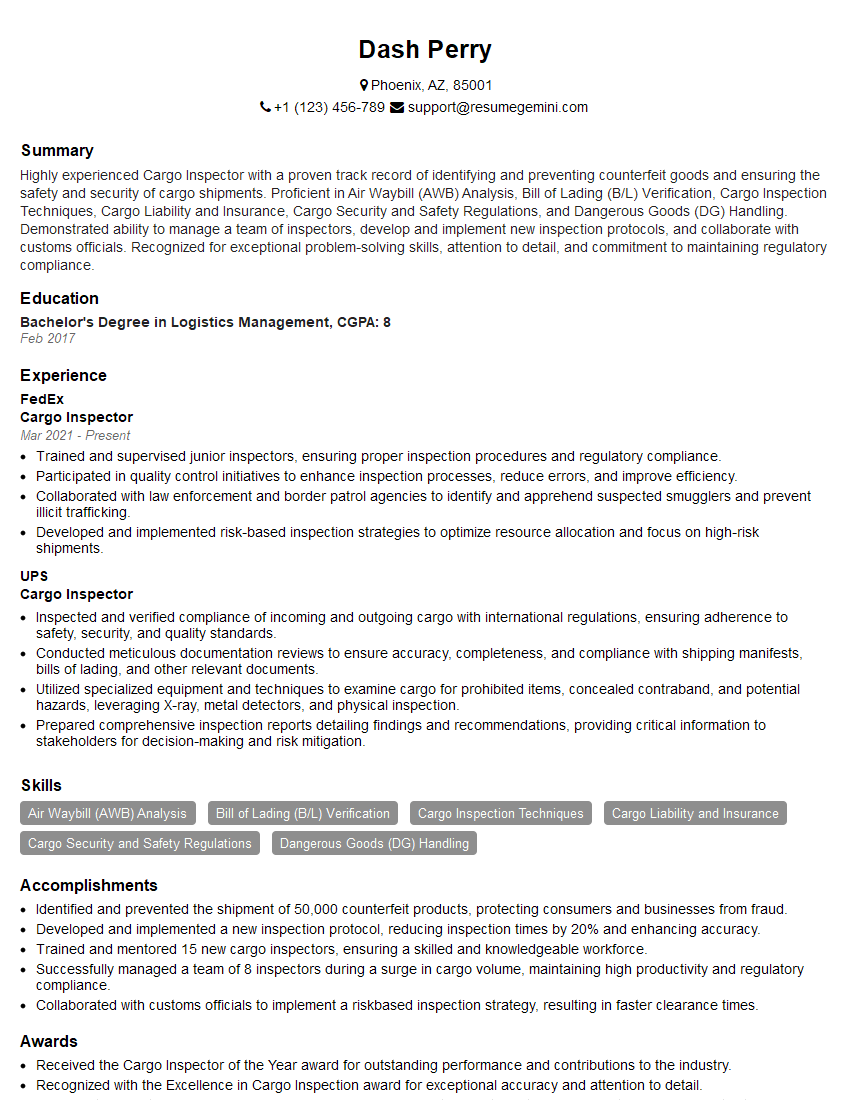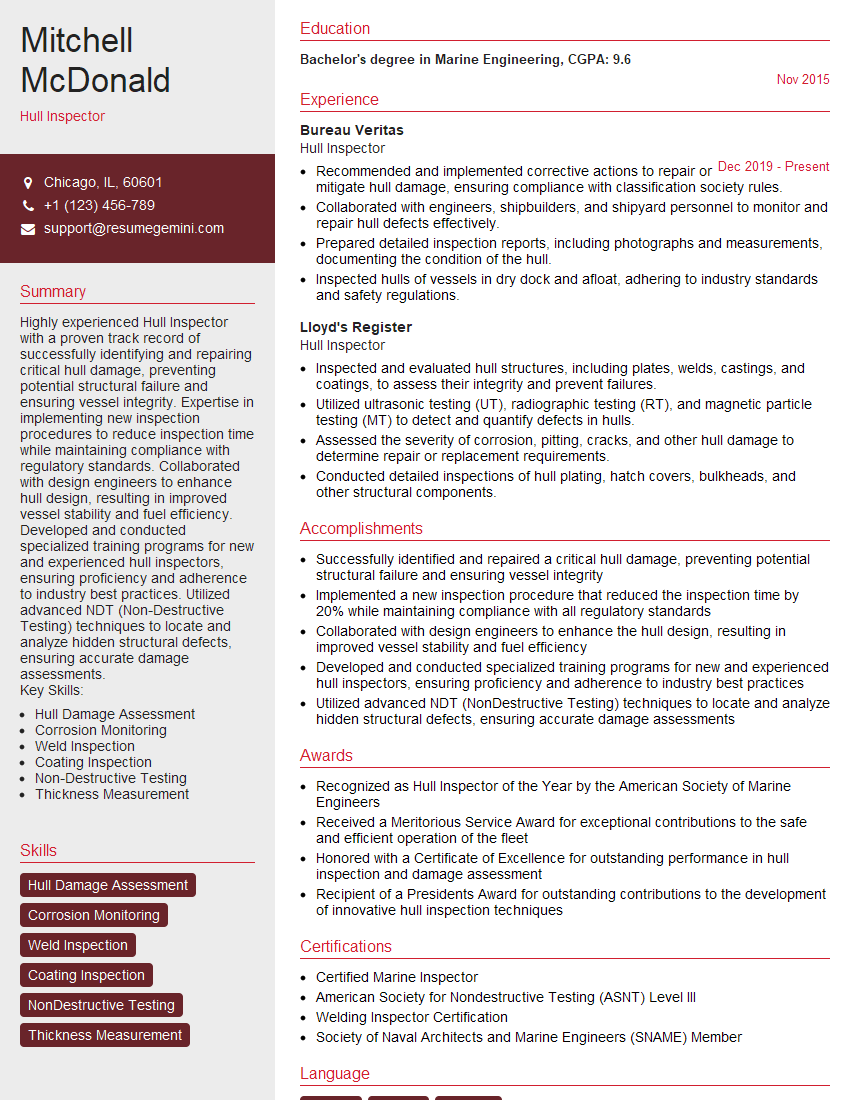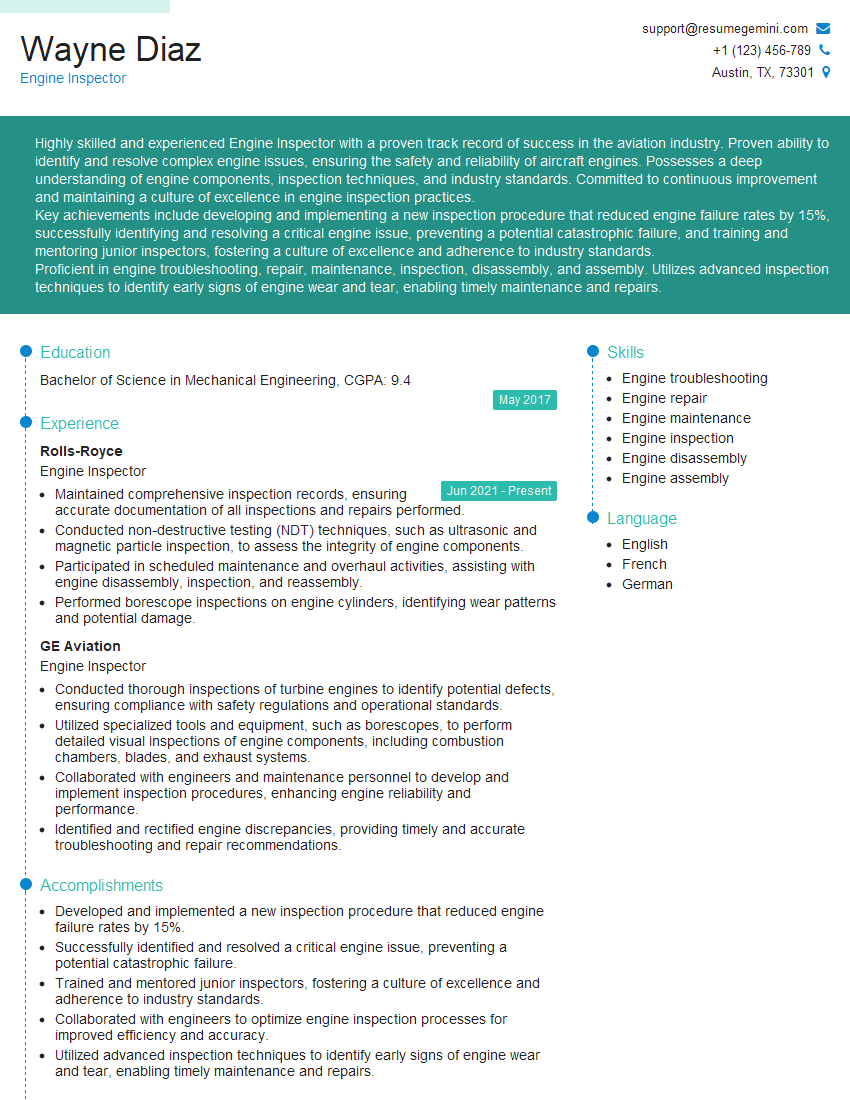Preparation is the key to success in any interview. In this post, we’ll explore crucial Marine Inspection interview questions and equip you with strategies to craft impactful answers. Whether you’re a beginner or a pro, these tips will elevate your preparation.
Questions Asked in Marine Inspection Interview
Q 1. Explain the different types of marine surveys.
Marine surveys are crucial for assessing the condition and seaworthiness of vessels. They fall into several categories, each serving a different purpose. Think of them as a comprehensive health check-up for a ship.
- Pre-purchase Surveys: Conducted before a vessel is bought to identify potential problems and assess its fair market value. It’s like a home inspection before buying a house.
- Condition and Valuation Surveys: Determine the overall condition of a vessel, often for insurance purposes or to establish its market value. This provides an objective assessment of the vessel’s worth.
- Insurance Surveys: Assess the vessel’s condition to determine insurance premiums and coverage. This is like getting car insurance – the condition of your vehicle affects the premium.
- Damage Surveys: Carried out after an accident or incident to determine the extent of damage and liability. Similar to an accident report for a car.
- Hull and Machinery Surveys: Focus specifically on the structural integrity of the hull and the functionality of the machinery. This is like checking the engine and body of a car.
- Special Surveys: Undertaken at specific intervals (as required by classification societies) to ensure compliance with safety standards and regulations. These are like mandatory car inspections.
The specific type of survey required depends on the vessel’s age, intended use, and the client’s needs.
Q 2. Describe your experience with hull inspections.
My experience with hull inspections is extensive. I’ve surveyed hundreds of vessels, ranging from small yachts to large cargo ships. A hull inspection is never routine; each vessel presents unique challenges. I always start with a thorough visual inspection, looking for signs of corrosion, damage, or structural weakness. This includes checking the plating, welds, and structural members for cracks, pitting, or deformation. I use non-destructive testing techniques like ultrasonic testing when necessary to assess areas inaccessible to visual inspection, or when there is suspicion of deeper damage.
For example, I once inspected a fishing vessel that had sustained significant damage from grounding. Through careful visual inspection and use of ultrasonic testing, we discovered hidden cracks in the hull plating, which were successfully repaired preventing a much larger and potentially more dangerous problem later.
Beyond visual inspection, I also pay close attention to the vessel’s history, including maintenance records and previous repairs. This information is crucial in understanding the vessel’s condition and predicting potential problems. A well-maintained vessel will have far fewer issues than one neglected.
Q 3. What are the key components of a pre-purchase survey?
A pre-purchase survey is an essential step before buying a vessel. It’s designed to protect the buyer by identifying any potential problems that could lead to costly repairs or even render the vessel unseaworthy. It’s a critical investment to avoid a costly mistake.
- Hull Inspection: Assessing the structural integrity of the hull for any signs of corrosion, damage, or wear and tear.
- Machinery Inspection: Evaluating the condition and performance of the vessel’s engines, generators, and other mechanical systems. This includes checking for leaks, corrosion, and proper functionality.
- Electrical Systems Inspection: Examining the vessel’s electrical systems for any faults or safety hazards. This includes wiring, switchboards and all electrical components.
- Deck and Superstructure Inspection: Checking the condition of the decks, railings, and other exterior structures for damage or deterioration.
- Safety Equipment Inspection: Verifying that all required safety equipment is present, in good working order, and compliant with regulations.
- Documentation Review: Examining the vessel’s maintenance records, certificates, and other relevant documentation. Ensuring that the vessel is compliant with regulations.
The final report will summarise the findings and provide a comprehensive assessment of the vessel’s condition and fair market value. Remember, even small issues can escalate into major problems.
Q 4. How do you assess the structural integrity of a vessel?
Assessing the structural integrity of a vessel is a complex process, requiring a combination of visual inspection, non-destructive testing (NDT), and a review of the vessel’s history. It’s like a doctor examining a patient – you need a holistic approach.
The process typically involves:
- Visual Inspection: A thorough examination of the hull, decks, and superstructure for signs of corrosion, cracking, deformation, or other damage.
- Non-Destructive Testing (NDT): Utilizing techniques like ultrasonic testing (UT), magnetic particle inspection (MPI), and radiographic testing (RT) to detect internal flaws or defects that are not visible to the naked eye. This is like using an X-ray machine to look inside.
- Thickness Measurement: Using specialized tools to measure the thickness of the hull plating and other structural members to assess corrosion rates and remaining service life. This reveals how much material is left.
- Review of Maintenance Records: Examination of the vessel’s maintenance history, including previous repairs and inspections, to understand the vessel’s overall condition and any potential vulnerabilities.
By combining these methods, we can build a comprehensive picture of the vessel’s structural integrity and identify potential hazards.
Q 5. Explain your understanding of SOLAS regulations.
The Safety of Life at Sea (SOLAS) Convention is an international maritime treaty that sets minimum safety standards for merchant ships. It’s crucial for ensuring the safety of passengers and crew. Think of it as a global safety code for all ships.
My understanding of SOLAS encompasses its various chapters, covering aspects like:
- Construction and Equipment: Standards for hull strength, fire protection, life-saving appliances, and radio communications.
- Life-saving Appliances: Regulations on lifeboats, life rafts, life jackets, and other lifesaving equipment.
- Fire Protection and Fire Prevention: Rules concerning fire detection, suppression, and escape routes.
- Radiocommunications: Requirements for radio equipment and procedures.
- Safety Management: Standards for the company’s safety management system (SMS) that covers operational safety.
Compliance with SOLAS is paramount. Non-compliance can lead to serious consequences, including detention of the vessel and hefty fines. As a marine surveyor, ensuring compliance with SOLAS regulations is an integral part of my work, protecting lives and preventing maritime accidents.
Q 6. Describe your experience with engine room inspections.
Engine room inspections are a critical part of any marine survey. They require a thorough understanding of marine engineering principles and a keen eye for detail. It’s akin to checking the heart of the ship.
My experience includes inspecting a wide range of engine room equipment, including:
- Main Engines: Checking for leaks, corrosion, proper lubrication, and overall condition. This includes checking the functionality of auxiliary systems.
- Auxiliary Engines: Assessing the operational status of generators, pumps, and other ancillary equipment.
- Piping Systems: Inspecting pipes and valves for corrosion, leaks, and proper insulation.
- Electrical Systems: Checking switchboards, wiring, and other electrical components for safety and proper function.
- Fire Protection Systems: Verifying the functionality of fire detection, alarm, and suppression systems. This is crucial for ship safety.
During inspections, I pay close attention to maintenance records and look for any signs of neglect or improper maintenance. A well-maintained engine room is a safe engine room.
Q 7. How do you identify and report potential safety hazards?
Identifying and reporting potential safety hazards is a top priority in marine inspection. My approach involves a systematic review that considers both immediate and latent risks. It’s like looking for both the obvious and the hidden dangers.
The process typically involves:
- Visual Inspection: Identifying any obvious hazards such as damaged equipment, loose wires, or inadequate safety signage.
- Operational Checks: Testing equipment to ensure it’s functioning correctly and meets safety standards.
- Documentation Review: Checking maintenance records, certificates, and other documents to identify any potential issues or areas of concern.
- Risk Assessment: Evaluating the likelihood and severity of potential hazards to determine the level of risk.
- Reporting: Clearly documenting all identified hazards and recommending appropriate corrective actions. I use a standardized reporting format to ensure clarity and consistency.
My reports are detailed and unambiguous, providing clear recommendations for addressing identified safety hazards to prevent potential accidents and ensure compliance with safety regulations.
Q 8. What is your experience with cargo inspections?
My experience with cargo inspections spans over 10 years, encompassing a wide range of commodities and vessel types. I’ve conducted pre-loading inspections to verify cargo stowage plans and ensure the integrity of packaging, preventing damage and ensuring compliance with safety regulations. During loading and discharge operations, I’ve overseen the proper handling and securing of cargo, preventing shifting and potential accidents. Post-discharge inspections verify the condition of the cargo and the cleanliness of the holds. For example, I once detected a significant infestation in a grain shipment during a pre-loading inspection, preventing a costly and potentially damaging voyage. This required immediate fumigation and prevented a major loss for the client. I’m proficient in using various inspection tools and techniques, including moisture meters, temperature sensors, and visual assessments to identify potential issues.
My experience extends to documenting all findings meticulously, preparing detailed reports with photographic evidence, and communicating findings clearly to all stakeholders, including the ship’s crew, cargo owners, and charterers. I’ve worked with various cargo types, from bulk goods like grains and ores to containers filled with manufactured goods and specialized projects cargo. Each cargo type demands a different inspection approach, and I’ve adapted my techniques accordingly.
Q 9. Explain your knowledge of MARPOL regulations.
MARPOL (International Convention for the Prevention of Pollution from Ships) is a crucial international agreement aimed at minimizing pollution from ships. My understanding encompasses all Annexes, particularly Annex I (oil pollution), Annex II (noxious liquid substances), Annex IV (sewage), and Annex V (garbage). I’m familiar with the specific requirements for each Annex, including record-keeping, discharge criteria, and the use of approved equipment.
For example, I regularly inspect oil record books to ensure accurate logging of oil transfers and discharges, checking for compliance with MARPOL’s regulations regarding oil discharge monitoring and control. I’m familiar with the various types of Oil Discharge Monitoring and Control systems (ODMCS) and the procedures for their testing and maintenance. Similarly, I verify the proper management of garbage, ensuring compliance with the segregation and disposal requirements as specified in Annex V. Non-compliance can result in significant fines and legal repercussions for the vessel and its operator.
I also understand the importance of the International Air Pollution Prevention (IAPP) certificate and its role in ensuring compliance with the emission control areas (ECAs). This understanding allows me to effectively assess a vessel’s compliance with MARPOL during inspections and report any discrepancies I find.
Q 10. How do you handle disagreements with vessel personnel?
Disagreements with vessel personnel are handled professionally and diplomatically, prioritizing safety and compliance. My approach involves clear, respectful communication, focusing on objective evidence and the relevant regulations. I start by explaining the issue clearly, referencing specific regulations or standards. I encourage open discussion and actively listen to the crew’s perspective. If the issue remains unresolved, I escalate the matter through the proper chain of command, documenting everything meticulously.
For instance, if there’s a dispute about the proper securing of cargo, I would calmly explain the relevant safety regulations and show photographic evidence of inadequate lashing. I would then work with the chief mate or officer in charge to rectify the situation. If this fails to resolve the issue, I would document the disagreement, including photos and witness statements, and report it to my superiors and potentially the flag state.
The key is to maintain a professional demeanor, emphasizing collaboration and a shared goal of safety and compliance. My experience has shown that a clear, well-documented approach, coupled with professional communication, usually leads to a satisfactory resolution.
Q 11. Describe your experience with documentation review (e.g., certificates, logs).
Documentation review is a critical part of any marine inspection. I have extensive experience reviewing various documents, including the International Ship Security Certificate (ISSC), Cargo Securing Manual, Stability Booklet, Oil Record Book, Garbage Record Book, and various certificates of class and compliance. I examine these documents for completeness, accuracy, and validity, ensuring they are up to date and compliant with relevant regulations.
For example, I would verify the validity of the vessel’s International Air Pollution Prevention (IAPP) certificate, ensuring it’s not expired and that the vessel is complying with emission control area (ECA) regulations. I will also check the accuracy of the Oil Record Book, ensuring that all entries are complete, legible, and properly signed. Inconsistencies or missing documentation can indicate potential non-compliance, which I would then investigate further.
My review process is methodical, involving a step-by-step check against the required documentation and regulations. Any discrepancies are noted and reported, and appropriate follow-up actions are recommended to resolve any identified deficiencies.
Q 12. What is your experience with ISM Code implementation?
The International Safety Management (ISM) Code is a crucial framework for ensuring safe management and operation of ships and for pollution prevention. My experience with ISM Code implementation includes auditing and verifying the effectiveness of safety management systems (SMS) onboard vessels. This involves reviewing the company’s safety and environmental protection policy, safety management procedures, and crew training records. I also conduct interviews with crew members to assess their understanding of safety procedures and the effectiveness of the onboard SMS.
I’ve reviewed SMS documentation to ensure it adequately addresses risk assessment, emergency response procedures, and maintenance schedules. I assess the adequacy of onboard training programs to ensure seafarers understand their roles and responsibilities under the SMS. For example, I would verify that the company’s safety and environmental protection policy is clearly communicated to all seafarers and that regular drills and exercises are conducted to ensure the crew is prepared for various emergency situations. Non-compliance with the ISM Code can lead to detention of the vessel and significant financial penalties.
Through my audits, I identify areas for improvement and make recommendations to enhance the effectiveness of the SMS. I provide constructive feedback and assist the company in developing corrective actions to address any deficiencies identified.
Q 13. How do you determine the seaworthiness of a vessel?
Determining a vessel’s seaworthiness involves a comprehensive assessment of its condition and compliance with relevant regulations. It’s not a single test but a holistic evaluation considering multiple factors. This includes a thorough visual inspection of the hull, superstructure, machinery, and equipment, checking for signs of damage, corrosion, or deterioration. I also review the vessel’s maintenance records to assess the condition of key systems and equipment, ensuring that regular maintenance has been carried out.
The structural integrity of the hull, including the condition of plating, welds, and bulkheads, is crucial. I check for evidence of overloading, improper repairs, or other structural deficiencies that might compromise the vessel’s seaworthiness. Furthermore, I examine the vessel’s lifesaving appliances, fire-fighting equipment, and navigation systems, ensuring they are properly maintained and functional. The adequacy of the crew’s training and experience is also an important factor in determining the overall seaworthiness of a vessel. The entire assessment process is meticulously documented, and any deficiencies identified are clearly reported with recommendations for corrective actions.
Imagine it like a thorough car inspection before a long road trip – checking tires, brakes, lights, and overall condition. Seaworthiness assessment is similar, but on a much larger and more complex scale, with far greater safety implications.
Q 14. Explain your understanding of stability calculations.
Understanding stability calculations is essential for ensuring the safe operation of a vessel. These calculations determine the vessel’s ability to remain upright and stable under various loading conditions. I’m familiar with the principles of hydrostatic stability, including the calculation of the vessel’s metacentric height (GM), which is a key indicator of its stability. A lower GM indicates a less stable vessel, making it more prone to capsizing. I’m proficient in using various software tools and manual methods for calculating stability, considering factors such as cargo weight, distribution, and the vessel’s displacement.
I can interpret stability curves and use them to assess the vessel’s stability in different loading conditions. I use this knowledge to evaluate the vessel’s stability during cargo loading and unloading operations, ensuring that it remains within safe limits throughout the voyage. For example, if a vessel is taking on a significant amount of ballast water, it’s critical to perform stability calculations to make sure that the vessel’s stability is not compromised.
Incorrect stability calculations can have devastating consequences, leading to vessel instability and potential capsizing. Therefore, my understanding of these calculations is paramount for ensuring safe operations and compliance with international maritime regulations.
Q 15. Describe your experience with tank inspections.
Tank inspections are a critical part of ensuring the safety and seaworthiness of a vessel. My experience encompasses a wide range of tank types, from fuel oil tanks and ballast tanks to cargo tanks carrying various liquids. Each inspection involves a multi-stage process.
- Visual Inspection: This involves a thorough examination of the tank’s interior and exterior for any signs of corrosion, damage, or leakage. I look for rust, pitting, dents, cracks, and any evidence of previous repairs. I use high-powered lighting and mirrors to reach difficult-to-access areas. For example, I once discovered a significant crack in a ballast tank during a visual inspection, which prevented a potential catastrophic failure at sea.
- Thickness Measurement: Using ultrasonic thickness gauges (more on this in a later answer), I measure the remaining thickness of the tank plating at various points to determine the extent of corrosion and assess its structural integrity. I compare the measurements to the allowable minimum thickness specified by the vessel’s classification society rules and regulations.
- Testing for Leaks and Vapour: This can involve pressure testing, vacuum testing, or using specialized gas detectors to ensure the integrity of the tank’s seals and prevent potential hazards.
- Documentation: All findings are meticulously documented, including photographs and detailed reports.
I’ve worked on vessels of various sizes and ages, gaining experience with different tank configurations and materials. This diverse experience enables me to quickly identify potential problems and recommend appropriate solutions.
Career Expert Tips:
- Ace those interviews! Prepare effectively by reviewing the Top 50 Most Common Interview Questions on ResumeGemini.
- Navigate your job search with confidence! Explore a wide range of Career Tips on ResumeGemini. Learn about common challenges and recommendations to overcome them.
- Craft the perfect resume! Master the Art of Resume Writing with ResumeGemini’s guide. Showcase your unique qualifications and achievements effectively.
- Don’t miss out on holiday savings! Build your dream resume with ResumeGemini’s ATS optimized templates.
Q 16. How do you assess the condition of life-saving appliances?
Assessing the condition of life-saving appliances is paramount to ensuring the safety of the crew and passengers. My assessment follows a standardized procedure, incorporating both visual inspection and practical testing.
- Visual Inspection: I examine the condition of the life rafts, life jackets, lifeboats, and other appliances, checking for any signs of damage, deterioration, or missing parts. I ensure that all safety equipment is correctly stowed, accessible and clearly marked.
- Practical Testing (where applicable): This often involves deploying and inspecting life rafts, testing the functionality of life jacket inflation mechanisms, and checking the operation of davits and winches for lifeboats. I carefully inspect the condition of the boat itself, checking the hull, engine, radio, and other essential components.
- Documentation: I record all observations, including any deficiencies or required maintenance. This usually includes photographic evidence and detailed reports, as well as noting any certifications or expiry dates.
For example, during an inspection, I once discovered a faulty release mechanism on a life raft. This highlighted a critical safety issue that was immediately addressed, preventing a potential life-threatening scenario.
Q 17. Explain your process for documenting inspection findings.
Meticulous documentation is essential for maintaining a clear and accurate record of all inspection findings. My process involves several key steps:
- Pre-Inspection Checklist: I start with a pre-defined checklist to ensure a consistent and thorough approach. This checklist aligns with relevant international maritime regulations and classification society requirements.
- Detailed Reporting: All findings, including both positive and negative observations, are documented in a detailed report. This includes descriptions of any deficiencies, their location, severity, and recommendations for corrective actions. Digital photography and videography are widely employed to support my findings.
- Use of Standardized Forms: I utilize standardized inspection forms to ensure consistency and facilitate easy data analysis. These forms clearly identify the vessel, location, date of inspection, and provide structured fields for describing findings and recommendations.
- Clear and Concise Language: My reports are written using clear and concise language, avoiding technical jargon where possible. They are easily understood by both technical and non-technical personnel.
- Digital Archiving: Completed inspection reports and supporting documentation are digitally archived for easy access and retrieval. This allows for effective tracking of maintenance and repair actions.
This comprehensive documentation system provides a valuable historical record for the vessel and facilitates ongoing maintenance planning.
Q 18. Describe your experience with using various inspection tools.
I’m proficient in using a range of inspection tools, tailored to the specific needs of the inspection. This includes:
- Ultrasonic Thickness Gauges: Essential for measuring the thickness of metal plates, helping to assess corrosion and structural integrity (explained further in the next answer).
- Magnetic Particle Inspection (MPI) and Dye Penetrant Inspection (DPI): These non-destructive testing methods are used to detect surface and near-surface cracks in metallic components.
- High-powered Lighting and Mirrors: Vital for accessing hard-to-reach areas during visual inspections.
- Gas Detectors: Used to detect flammable and toxic gases within tanks and enclosed spaces, preventing potential hazards.
- Digital Cameras and Video Recording Equipment: Documentation tools, providing photographic and video evidence for my findings.
- Levels and Gauges: For measuring fluid levels in tanks.
My familiarity with these various tools ensures a thorough and accurate inspection, enabling me to identify potential problems before they escalate into serious safety issues.
Q 19. How do you manage a high-volume workload?
Managing a high-volume workload requires a systematic and organized approach. My strategy combines efficient time management, prioritization, and effective delegation (where applicable).
- Prioritization: I prioritize inspections based on urgency and risk. Safety-critical inspections, such as those involving life-saving appliances or cargo tanks, take precedence.
- Time Management: I utilize scheduling software and detailed checklists to ensure efficient use of time. This helps to avoid unnecessary delays and maintain a consistent workflow.
- Systematic Approach: I follow a structured inspection process for every vessel, ensuring consistency and thoroughness. This helps to optimize the time spent on each inspection.
- Regular Review and Adjustment: I regularly review my workload and adjust my schedule as needed, accounting for unexpected delays or urgent requests.
My experience has taught me the importance of adaptability and efficient work habits. I believe in working smart, not just hard, to manage even the most demanding workloads effectively and efficiently.
Q 20. How do you stay current with changes in maritime regulations?
Staying current with changes in maritime regulations is crucial for maintaining competence and ensuring compliance. My approach includes:
- Subscription to Regulatory Updates: I subscribe to newsletters and publications from relevant regulatory bodies, such as the IMO (International Maritime Organization), and national maritime authorities.
- Professional Development Courses: I regularly attend professional development courses and seminars to stay abreast of the latest regulations and best practices. This includes attending webinars and online training programs.
- Networking with Colleagues: I actively network with other marine inspectors and professionals in the industry to share knowledge and insights on recent regulatory changes and interpretations.
- Review of Classification Society Guidelines: I regularly consult the latest guidelines issued by classification societies, such as DNV GL, ABS, and Lloyd’s Register, to ensure my inspections meet the highest standards.
Continuous learning is essential in this field; staying informed helps me provide the highest standard of service and ensure vessel compliance.
Q 21. Describe your experience in using a thickness gauge.
The ultrasonic thickness gauge is an indispensable tool in marine inspections, particularly for assessing the extent of corrosion in metal structures. It works by emitting high-frequency sound waves into the material and measuring the time it takes for the waves to reflect back. This time is then used to calculate the thickness of the material.
- Calibration: Before using the gauge, it’s crucial to calibrate it using a standard block of known thickness. This ensures accurate measurements.
- Couplant: A couplant (usually a gel) is applied between the gauge and the material to ensure good acoustic contact and prevent inaccurate readings caused by air gaps.
- Measurement Technique: I take multiple measurements at various locations, accounting for potential variations in thickness due to corrosion. I typically take readings at several points across a given area.
- Data Recording: All measurements are meticulously recorded, along with the location of each reading. This data is crucial for evaluating the condition of the structure and determining whether it meets regulatory requirements.
- Interpretation: I interpret the readings by comparing them to the minimum allowable thickness specified by the vessel’s class rules. If the measured thickness falls below the acceptable minimum, it may indicate a need for further investigation or repair.
For example, using a thickness gauge on a fuel oil tank, I once discovered significant thinning due to corrosion in an area that was previously masked by paint. This early detection prevented a potential catastrophic failure.
Q 22. How do you handle emergency situations during inspections?
Emergency situations during marine inspections demand swift, decisive action. My approach prioritizes safety and minimizing further damage. This involves immediately assessing the situation, prioritizing life safety, and then moving to mitigate the immediate threat.
For example, if I discover a significant fire hazard during a tank inspection, my immediate actions would be: 1) Evacuate personnel from the area; 2) Alert the vessel’s emergency response team; 3) Isolate the affected area to prevent the spread of fire; and 4) Coordinate with relevant authorities, such as coast guard, as needed. Detailed reporting of the incident, including contributing factors and recommendations for preventing recurrence, forms the final step.
In a scenario involving a flooding compartment, the priorities shift to containing the flood, determining the source, and assessing structural integrity. I would immediately communicate with the vessel’s crew to implement damage control measures. Subsequently, a thorough investigation into the cause of the flooding would be undertaken, culminating in a detailed report specifying the deficiencies found and recommendations for rectification.
Q 23. Explain the difference between a condition survey and a damage survey.
While both condition surveys and damage surveys assess a vessel’s condition, their purposes and scopes differ significantly. A condition survey is a comprehensive assessment of a vessel’s overall state, conducted for various reasons, including sale, purchase, insurance, or classification purposes. It involves a detailed examination of the hull, machinery, equipment, and systems to ascertain its condition and identify potential future maintenance needs. Think of it as a general health check-up.
A damage survey, conversely, is focused on a specific incident or event that has caused damage to the vessel. It aims to determine the extent of the damage, its cause, and liability. It’s akin to visiting a doctor after an accident. The damage survey will often involve detailed photographic and video documentation and will specifically address the cause and extent of the damage, providing estimates of repair costs and assessing the seaworthiness of the vessel.
For instance, a condition survey would assess the general state of the vessel’s main engine, including its operational readiness and the wear on its components, while a damage survey would investigate the cause and extent of damage following a collision with another vessel.
Q 24. Describe your familiarity with international maritime conventions.
My familiarity with international maritime conventions is extensive, encompassing key regulations like the International Convention for the Safety of Life at Sea (SOLAS), the International Maritime Organisation (IMO) performance standards, and the International Convention on Load Lines (LL). I understand how these conventions apply to various vessel types and operational scenarios.
I’m particularly knowledgeable about SOLAS regulations concerning life-saving appliances, fire protection, and safety management systems. My understanding extends to the various codes and guidelines under SOLAS and how they are implemented practically. For example, I know the requirements for lifeboat drills, the specifications for fire-fighting equipment, and the documentation needed for compliance with the Safety Management System (SMS) code.
Furthermore, my familiarity with the MARPOL Convention (International Convention for the Prevention of Pollution from Ships) is strong, covering its impact on vessel operations, waste management, and oil discharge prevention. I can assess a vessel’s adherence to these standards.
Q 25. How do you ensure your inspections are unbiased and objective?
Maintaining impartiality and objectivity is paramount in marine inspections. My approach emphasizes several key strategies. First, I adhere to a standardized inspection procedure, following established checklists and guidelines to ensure thoroughness and consistency. This minimizes subjective judgment and promotes a systematic approach.
Second, I utilize calibrated instruments and equipment for all measurements and testing. This ensures accuracy and prevents bias. Third, I maintain a detailed record of all observations and findings, with supporting photographic and video evidence. This creates a transparent and verifiable inspection record.
Finally, I’m committed to continuous professional development, staying abreast of the latest industry standards and best practices. This helps prevent any unconscious biases that may be rooted in outdated knowledge or incomplete training. My commitment to ethical conduct also ensures unbiased and objective inspections.
Q 26. What is your experience with offshore platform inspections?
I possess considerable experience in offshore platform inspections, including fixed platforms, floating production storage and offloading (FPSO) units, and jack-up rigs. My experience encompasses various aspects, from structural integrity assessments to inspections of safety-critical systems and equipment.
This experience includes evaluating the condition of subsea pipelines and risers; assessing the functionality and integrity of safety systems like fire and gas detection; checking lifeboat and escape routes; inspecting lifting equipment (cranes, derricks); and reviewing the platform’s operational procedures and emergency response plans. I’ve also been involved in inspections following accidents or incidents to determine their causes and recommend preventative measures.
In one particular instance, I was involved in the inspection of a jack-up rig following a significant storm. The inspection involved a thorough assessment of the structural integrity of the legs, the foundation, and the deck, ensuring the rig’s seaworthiness before resuming operations.
Q 27. Describe your understanding of load line regulations.
Load line regulations, as defined by the International Convention on Load Lines, dictate the maximum depth to which a vessel can be loaded, ensuring its stability and preventing potential capsizing. These regulations account for factors such as the vessel’s type, size, and the anticipated weather conditions. The load line marks on the hull indicate the safe load limits under different circumstances, considering factors like season and geographic area.
Understanding load line regulations necessitates knowledge of various load line marks (e.g., summer, winter, tropical, fresh water), their significance, and the relevant calculations required to determine a vessel’s safe load limit based on specific circumstances. Non-compliance with load line regulations can lead to dangerous situations, potentially causing instability, capsizing, and significant damage or loss of life.
During inspections, I meticulously check the vessel’s load line markings, ensuring they are clearly visible, properly maintained, and in accordance with the vessel’s specifications and the relevant international regulations. I also verify that the vessel is not overloaded beyond the stipulated limits.
Q 28. Explain your experience with reporting non-conformities.
Reporting non-conformities is a critical aspect of marine inspections. My approach involves a methodical process that ensures clarity, accuracy, and thoroughness. Initially, I meticulously document all non-conformities, using a standardized format that includes clear descriptions of the deficiencies, their locations, and their severity. Detailed photographic and video evidence supports my findings, eliminating ambiguity.
The reports clearly state the applicable regulations or standards being violated and explain the potential safety or operational risks associated with each non-conformity. For example, if a fire extinguisher is missing, the report will not only mention the missing extinguisher but will also detail the relevant SOLAS regulation concerning fire suppression. I provide recommendations for corrective actions, ensuring these are both feasible and practical. Severity levels are assigned to prioritize urgent actions.
The final report is then reviewed and verified for accuracy before it’s formally submitted. The format and method of submission adhere to the standards required by the relevant authority or client. I also follow up to ensure the recommended corrective actions are implemented and the non-conformities are effectively resolved. The follow-up might involve revisiting the vessel to verify that the issues have been rectified.
Key Topics to Learn for Marine Inspection Interview
- Vessel Stability and Trim: Understanding principles of buoyancy, stability calculations, and the impact of cargo loading on vessel stability. Practical application: Analyzing loading plans and identifying potential stability issues.
- Hull Structure and Integrity: Knowledge of different hull types, material properties, and common structural defects. Practical application: Assessing the condition of a vessel’s hull during an inspection, identifying potential corrosion or damage.
- Marine Engineering Systems: Familiarity with main and auxiliary engines, propulsion systems, and associated machinery. Practical application: Troubleshooting engine malfunctions and ensuring safe operation.
- Safety Regulations and Compliance: Deep understanding of relevant international and national maritime regulations (SOLAS, MARPOL, etc.). Practical application: Conducting safety inspections, ensuring compliance with regulations, and identifying safety deficiencies.
- Damage Control and Emergency Procedures: Knowledge of fire prevention, firefighting techniques, and emergency response protocols. Practical application: Developing and implementing effective emergency response plans.
- Navigation and Communication Systems: Understanding of GPS, radar, and other navigational equipment, as well as communication systems (VHF, GMDSS). Practical application: Evaluating the functionality and accuracy of navigational and communication systems.
- Pollution Prevention and Response: Knowledge of oil pollution prevention techniques and procedures for responding to oil spills. Practical application: Inspecting oil-handling equipment and ensuring compliance with environmental regulations.
- Documentation and Record Keeping: Understanding the importance of accurate record-keeping and documentation related to vessel inspections and maintenance. Practical application: Maintaining and interpreting vessel logs and certificates.
Next Steps
Mastering Marine Inspection opens doors to a rewarding career with excellent growth potential, offering specialization opportunities and higher earning capacity. To maximize your job prospects, it’s crucial to present your skills effectively. Creating an ATS-friendly resume is essential for getting your application noticed by recruiters. We recommend using ResumeGemini to build a professional and impactful resume that highlights your qualifications. ResumeGemini provides examples of resumes tailored to the Marine Inspection field to guide you through the process, ensuring your application stands out from the competition.
Explore more articles
Users Rating of Our Blogs
Share Your Experience
We value your feedback! Please rate our content and share your thoughts (optional).
What Readers Say About Our Blog
good

